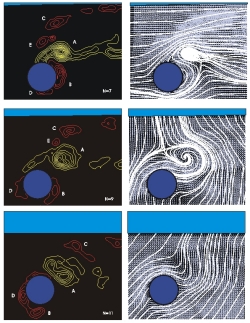You are here
Home ›Free-Surface Wave Interaction with a Stationary Horizontal Cylinder
Free-surface wave interaction with a stationary horizontal cylinder. A free-surface wave system induces formation of pronounced concentrations of positive and negative vorticity from the cylinder. Vorticity concentration A initially moves up and away from the surface of the cylinder (N = 9) and reverses direction to eventually collide with the surface of the cylinder (N = 11). Simultaneously, concentrations B and D form along the surface of the cylinder (N = 7) and migrate about the cylinder in the clockwise direction (N = 9). Concentration B eventually separates from its surface (N = 11). Concentration C undergoes large-scale orbital motion about the cylinder. The corresponding patterns of velocity and streamline topology indicate that even though the pattern of vorticity concentrations of frame N = 9 is mildly altered relative to that at N = 7, the change in predominant direction of the wave velocity field induces a dramatic switch in location of the saddle point and, in frame N = 11, this type of singularity is no longer evident.
Classes of vortex formation from a horizontal cylinder adjacent to an undulating free-surface wave are characterized using high-image-density particle image velocimetry. Instantaneous representations of the velocity field, streamline topology and vorticity patterns yield insight into the origin of unsteady loading of the cylinder. For sufficiently deep submergence of the cylinder, the orbital nature of the wave motion results in multiple sites of vortex development, i.e., onset of vorticity concentrations, along the surface of the cylinder, followed by distinctive types of shedding from the cylinder. All of these concentrations of vorticity then exhibit orbital motion about the cylinder. Their contributions to the instantaneous values of the force coefficients are assessed by calculating moments of vorticity. It is shown that large contributions to the moments and their rate of change with time can occur for those vorticity concentrations having relatively small amplitude orbital trajectories. In a limiting case, collision with the surface of the cylinder can occur. Such vortex-cylinder interactions exhibit abrupt changes in the streamline topology during the wave cycle, including abrupt switching of the location of saddle points in the wave. The effect of nominal depth of submergence of the cylinder is characterized in terms of the time history of patterns of vorticity generated from the cylinder and the free-surface. Generally speaking, generic types of vorticity concentrations are formed from the cylinder during the cycle of the wave motion for all values of submergence. The proximity of the free-surface, however, can exert a remarkable influence on: the initial formation; the eventual strength; and the subsequent motion of concentrations of vorticity. For sufficiently shallow submergence, large-scale vortex formation from the upper surface of the cylinder is inhibited and, in contrast, that from the lower surface of the cylinder is intensified. Moreover, decreasing the depth of submergence retards the orbital migration of previously-shed concentrations of vorticity about the cylinder.

